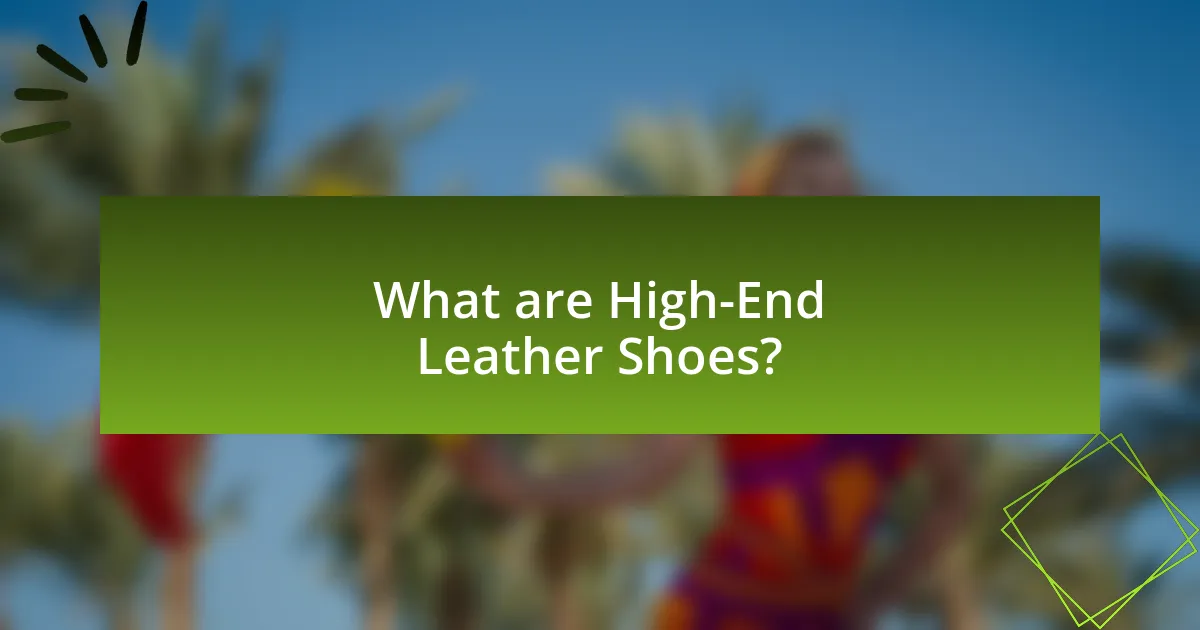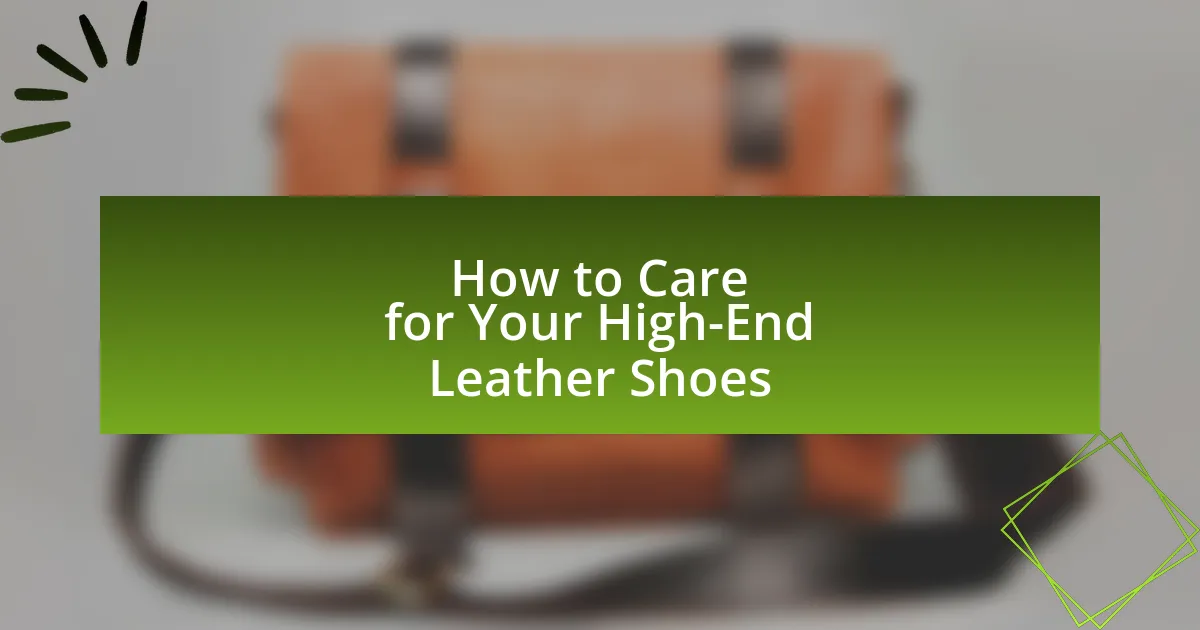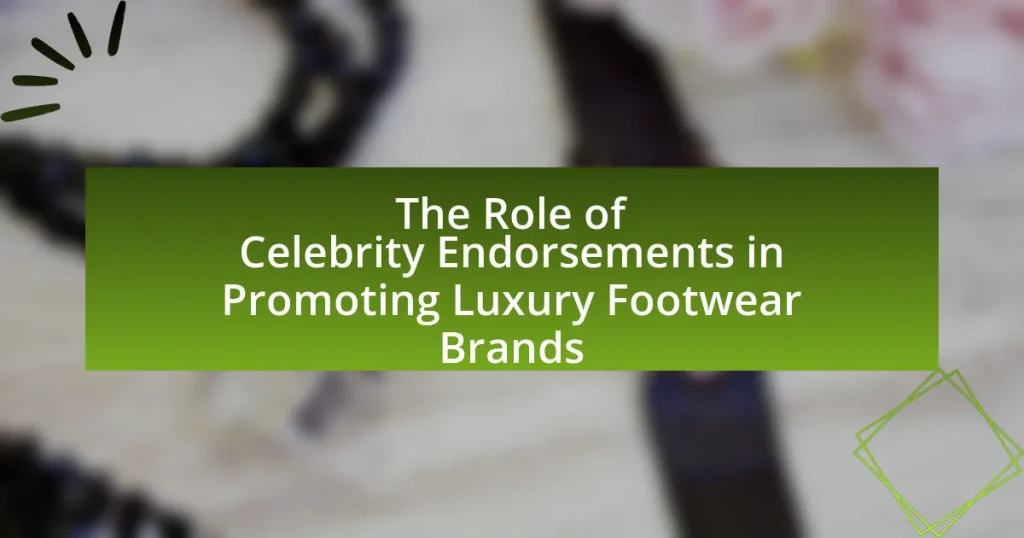High-end leather shoes are premium footwear made from high-quality materials, such as full-grain and top-grain leather, known for their durability and luxurious appearance. This article provides a comprehensive guide on how to care for these shoes, emphasizing the importance of proper maintenance to preserve their quality and longevity. Key topics include the differences between high-end and regular leather shoes, the significance of craftsmanship, common types of high-end shoes, and best practices for cleaning, conditioning, and storing them. Additionally, it addresses the risks of neglecting shoe care and offers troubleshooting tips for common issues like scuffs and water damage.

What are High-End Leather Shoes?
High-end leather shoes are premium footwear crafted from high-quality leather, often featuring superior craftsmanship and design. These shoes typically utilize full-grain or top-grain leather, which is known for its durability and luxurious appearance. The construction methods, such as Goodyear welt or Blake stitch, enhance their longevity and comfort. High-end leather shoes are often associated with luxury brands and are designed to provide both style and functionality, making them a worthwhile investment for discerning consumers.
How do high-end leather shoes differ from regular leather shoes?
High-end leather shoes differ from regular leather shoes primarily in quality, craftsmanship, and materials used. High-end shoes are typically made from premium leather, such as full-grain or top-grain leather, which is more durable and develops a rich patina over time, while regular leather shoes often use corrected grain or synthetic materials that lack longevity and character. Additionally, high-end shoes feature superior construction techniques, such as Goodyear welt or Blake stitching, which enhance durability and comfort, whereas regular shoes may employ simpler methods that compromise these attributes. This distinction in quality and craftsmanship results in high-end leather shoes offering better fit, longevity, and aesthetic appeal compared to their regular counterparts.
What materials are typically used in high-end leather shoes?
High-end leather shoes are typically made from full-grain leather, which is the highest quality leather available, known for its durability and natural appearance. Additionally, high-end shoes may incorporate materials such as suede, calfskin, and exotic leathers like alligator or ostrich, which enhance both aesthetics and comfort. Full-grain leather retains the natural grain and texture, making it more breathable and resistant to wear over time, while calfskin is prized for its softness and smooth finish. The use of these premium materials ensures that high-end leather shoes not only look sophisticated but also provide longevity and comfort.
Why is craftsmanship important in high-end leather shoes?
Craftsmanship is crucial in high-end leather shoes because it directly influences the quality, durability, and aesthetic appeal of the footwear. High-quality craftsmanship ensures that each shoe is meticulously constructed, using premium materials and techniques that enhance comfort and longevity. For instance, hand-stitching techniques, often employed in luxury shoe production, provide greater strength and flexibility compared to machine stitching, resulting in a better fit and extended lifespan. Additionally, skilled artisans pay attention to details such as leather selection, finishing, and construction methods, which contribute to the overall elegance and uniqueness of each pair. This level of craftsmanship not only elevates the shoe’s performance but also justifies the higher price point associated with luxury footwear.
What are the common types of high-end leather shoes?
Common types of high-end leather shoes include Oxfords, Brogues, Loafers, Derbies, and Monk Straps. Oxfords are characterized by their closed lacing system, making them a formal choice. Brogues feature decorative perforations and can be found in various styles, including Oxfords and Derbies. Loafers are slip-on shoes that offer a more casual yet sophisticated look. Derbies have an open lacing system, providing a slightly less formal appearance than Oxfords. Monk Straps are distinguished by their buckle closure, offering a unique alternative to traditional laces. These classifications are widely recognized in the fashion industry, with high-end brands often specializing in these styles to cater to discerning customers.
What distinguishes oxfords from loafers in high-end shoes?
Oxfords are distinguished from loafers in high-end shoes primarily by their construction and closure style. Oxfords feature a closed lacing system, where the eyelets are sewn under the vamp, providing a more formal and structured appearance. In contrast, loafers are slip-on shoes without laces, characterized by their ease of wear and more casual aesthetic. This difference in design influences their suitability for various occasions, with oxfords typically being favored for formal events and loafers for more relaxed settings.
How do dress boots compare to casual high-end leather shoes?
Dress boots are generally more formal and structured compared to casual high-end leather shoes, which tend to be more versatile and relaxed in style. Dress boots often feature a higher shaft and a more polished finish, making them suitable for formal occasions and professional settings. In contrast, casual high-end leather shoes, such as loafers or brogues, offer a blend of comfort and style, making them appropriate for everyday wear while still maintaining a sophisticated appearance. The construction of dress boots typically includes sturdier materials and a more rigid sole, providing additional support and durability, while casual shoes may prioritize flexibility and ease of wear.

Why is Proper Care Essential for High-End Leather Shoes?
Proper care is essential for high-end leather shoes because it preserves their quality, appearance, and longevity. High-end leather is often made from premium materials that require specific maintenance to prevent damage such as cracking, fading, or water stains. Regular cleaning, conditioning, and protection with appropriate products can extend the life of the shoes significantly, often by several years. For instance, a study by the Leather Research Centre indicates that well-maintained leather can last up to three times longer than poorly cared-for leather. This demonstrates that investing time in proper care not only enhances the aesthetic appeal but also ensures the durability of high-end leather shoes.
What are the risks of neglecting high-end leather shoe care?
Neglecting high-end leather shoe care can lead to significant damage, including cracking, discoloration, and loss of shape. High-quality leather requires regular maintenance to preserve its natural oils and prevent drying out; without this care, the material can become brittle and develop unsightly creases. Additionally, neglect can result in the accumulation of dirt and moisture, which may cause mold growth and further deterioration. Studies indicate that properly maintained leather can last up to 10 years longer than neglected leather, underscoring the importance of consistent care.
How can improper care affect the longevity of high-end leather shoes?
Improper care can significantly reduce the longevity of high-end leather shoes by causing damage such as cracking, discoloration, and loss of shape. High-end leather requires regular cleaning, conditioning, and protection from moisture and extreme temperatures to maintain its integrity. For instance, neglecting to clean dirt and salt can lead to stains and deterioration of the leather fibers. Additionally, failing to apply appropriate leather conditioner can result in dryness and cracking, as leather loses its natural oils over time. Studies indicate that well-maintained leather can last decades, while poorly cared-for leather may only last a few years, underscoring the importance of proper care in extending the lifespan of high-end leather footwear.
What are the signs of wear and tear in high-end leather shoes?
The signs of wear and tear in high-end leather shoes include creasing, scuffing, discoloration, and sole deterioration. Creasing typically occurs at the toe box and indicates that the leather is losing its structural integrity. Scuffing appears as scratches or marks on the surface, often resulting from contact with rough surfaces. Discoloration can manifest as fading or darkening of the leather, which may be caused by exposure to sunlight or moisture. Sole deterioration is evident when the outsole shows significant wear, such as thinning or cracking, which compromises the shoe’s comfort and support. These signs are critical indicators that high-end leather shoes require maintenance or repair to prolong their lifespan.
How does proper care enhance the appearance of high-end leather shoes?
Proper care significantly enhances the appearance of high-end leather shoes by maintaining their luster, preventing damage, and prolonging their lifespan. Regular cleaning removes dirt and grime that can dull the leather, while conditioning nourishes the material, keeping it supple and preventing cracks. Additionally, polishing adds a protective layer and restores shine, making the shoes look new. Studies show that well-maintained leather can retain its aesthetic appeal for years longer than neglected leather, underscoring the importance of proper care in preserving the visual quality of high-end footwear.
What role does polishing play in maintaining high-end leather shoes?
Polishing plays a crucial role in maintaining high-end leather shoes by providing protection, enhancing appearance, and prolonging the lifespan of the leather. Regular polishing creates a protective layer that guards against moisture, dirt, and scuffs, which can damage the leather over time. Additionally, polishing restores the shoe’s luster and color, making them look well-maintained and visually appealing. The process also nourishes the leather, preventing it from drying out and cracking, which is essential for preserving the integrity of high-quality materials.
How does conditioning leather improve its texture and durability?
Conditioning leather enhances its texture and durability by replenishing essential oils and moisture that prevent drying and cracking. When leather is conditioned, it becomes more supple and flexible, which improves its overall feel and appearance. Additionally, conditioning creates a protective barrier against environmental factors such as water and dirt, thereby extending the lifespan of the leather. Regular conditioning can significantly reduce the risk of damage, as studies show that well-maintained leather can last up to five times longer than untreated leather.

What are the Best Practices for Caring for High-End Leather Shoes?
The best practices for caring for high-end leather shoes include regular cleaning, conditioning, and proper storage. Regular cleaning involves using a soft brush or cloth to remove dirt and dust, while conditioning helps maintain the leather’s suppleness and prevents cracking. It is recommended to use a high-quality leather conditioner every few months. Proper storage requires keeping shoes in a cool, dry place, ideally in dust bags or boxes to protect them from dust and light. Additionally, using shoe trees can help maintain their shape and absorb moisture. These practices are essential for prolonging the life and appearance of high-end leather shoes.
How should you clean high-end leather shoes effectively?
To clean high-end leather shoes effectively, start by removing dirt and dust with a soft brush or cloth. This initial step prevents scratches during the cleaning process. Next, use a leather cleaner specifically formulated for high-end leather, applying it with a soft cloth in circular motions. After cleaning, allow the shoes to dry naturally away from direct heat sources. Finally, apply a high-quality leather conditioner to maintain suppleness and prevent cracking, ensuring the longevity of the leather. Regular maintenance, including cleaning and conditioning, is essential for preserving the appearance and durability of high-end leather shoes.
What cleaning products are safe for high-end leather shoes?
Cleaning products that are safe for high-end leather shoes include pH-balanced leather cleaners, saddle soap, and specialized leather conditioners. These products are formulated to clean without damaging the leather’s natural oils or finish. For instance, pH-balanced leather cleaners effectively remove dirt and stains while maintaining the integrity of the leather. Saddle soap is also a traditional choice that cleans and conditions leather, ensuring it remains supple. Additionally, using a specialized leather conditioner after cleaning helps to restore moisture and protect against cracking.
How often should you clean your high-end leather shoes?
You should clean your high-end leather shoes every two to four weeks, depending on usage and environmental conditions. Regular cleaning helps maintain the leather’s appearance and longevity by removing dirt and preventing damage from moisture. For instance, shoes worn frequently in wet or muddy conditions may require more frequent cleaning, while those used less often can be cleaned less frequently.
What techniques should you use for conditioning high-end leather shoes?
To condition high-end leather shoes, use a high-quality leather conditioner specifically formulated for luxury leather. Apply the conditioner evenly using a soft cloth, ensuring to cover all areas, including seams and creases, to maintain suppleness and prevent cracking. Allow the conditioner to absorb for at least 15 minutes before buffing with a clean, dry cloth to restore shine. Regular conditioning every 3-6 months is recommended to keep the leather hydrated and extend the lifespan of the shoes.
How do you choose the right conditioner for your leather shoes?
To choose the right conditioner for your leather shoes, select a product specifically formulated for the type of leather used in your shoes. High-quality leather conditioners contain natural oils and waxes that nourish and protect the leather without causing damage. For example, conditioners with lanolin or mink oil are effective for softening and waterproofing leather. Additionally, ensure the conditioner is free from harsh chemicals that can degrade the leather over time. Always test the conditioner on a small, inconspicuous area first to confirm compatibility.
What is the best method for applying conditioner to leather shoes?
The best method for applying conditioner to leather shoes involves using a soft cloth to evenly distribute the conditioner. First, ensure the shoes are clean and dry. Then, apply a small amount of conditioner to the cloth and gently rub it into the leather in circular motions, covering the entire surface. This technique allows for better absorption and prevents over-saturation, which can damage the leather. Regular conditioning, typically every 3-6 months, helps maintain the leather’s suppleness and prevents cracking, as recommended by leather care experts.
How can you protect high-end leather shoes from damage?
To protect high-end leather shoes from damage, regularly apply a high-quality leather conditioner and waterproofing spray. Leather conditioner maintains the material’s suppleness and prevents cracking, while waterproofing spray creates a barrier against moisture and stains. Studies show that conditioned leather can last significantly longer, with some sources indicating an increase in lifespan by up to 50% when properly maintained. Additionally, storing shoes in a cool, dry place and using shoe trees can help retain their shape and prevent creasing.
What types of protective sprays are recommended for leather shoes?
Waterproofing sprays and stain repellents are recommended for leather shoes. Waterproofing sprays create a barrier against moisture, preventing water damage and stains. Stain repellents, on the other hand, help to resist dirt and oil, maintaining the shoe’s appearance. Products containing silicone or fluoropolymer are particularly effective, as they provide long-lasting protection without altering the leather’s texture. For instance, brands like Kiwi and Scotchgard offer specialized formulations designed for leather, ensuring that the shoes remain both protected and breathable.
How can you store high-end leather shoes to prevent damage?
To store high-end leather shoes and prevent damage, keep them in a cool, dry place away from direct sunlight. This environment helps maintain the leather’s integrity and prevents fading or cracking. Additionally, use shoe trees to help retain their shape and absorb moisture, which can lead to mold and mildew if left unchecked. Storing shoes in breathable dust bags rather than plastic containers allows air circulation, further protecting the leather. These practices are supported by leather care experts who emphasize the importance of proper storage conditions to prolong the lifespan of high-quality leather footwear.
What are some common troubleshooting tips for high-end leather shoe care?
To care for high-end leather shoes, common troubleshooting tips include using a soft brush to remove dirt, applying a high-quality leather conditioner to maintain suppleness, and using a waterproofing spray to protect against moisture. Regularly cleaning with a damp cloth prevents stains from setting, while storing shoes with cedar shoe trees helps maintain their shape and absorb moisture. These practices are essential for preserving the integrity and appearance of luxury leather footwear.
How can you remove scuffs from high-end leather shoes?
To remove scuffs from high-end leather shoes, gently rub the scuffed area with a soft cloth or a leather eraser specifically designed for this purpose. This method effectively lifts the scuff marks without damaging the leather. Additionally, applying a small amount of leather conditioner after removing the scuff can restore moisture and shine, ensuring the leather remains supple and protected. This approach is validated by leather care experts who recommend using non-abrasive materials to maintain the integrity of high-end leather.
What should you do if your high-end leather shoes get wet?
If your high-end leather shoes get wet, immediately blot the excess water with a soft, absorbent cloth to prevent water stains. After blotting, allow the shoes to air dry at room temperature, avoiding direct heat sources like radiators or hair dryers, which can damage the leather. Once dry, apply a high-quality leather conditioner to restore moisture and flexibility, as wet leather can become stiff and cracked. This method is effective because leather is porous and can absorb moisture, leading to potential damage if not treated properly.



